Proposed budget would gut transit spending, passenger rail funding
The budget proposal from the Republican Study Committee, which consists of 165 of the 242 GOP House members, released a week or so ago, calls for completely eliminating the main federal transit program, zeroes out Amtrak, cuts all funding for the metro system in the nation’s capital and slashes $2.5 billion in high-speed rail grants. Sign our petition objecting to this assault on public transportation funding.
New report shows the job-creating potential of smart transportation investments
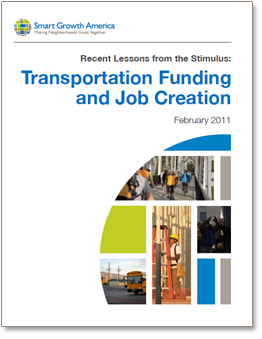 Smart Growth America is out with a report demonstrating the potential for smart transportation spending to create jobs today and grow our economy tomorrow. According to data sent by the states to Congress, the states that created the most jobs invested their stimulus funds in public transportation and projects that maintained and repaired existing roads and bridges.
Smart Growth America is out with a report demonstrating the potential for smart transportation spending to create jobs today and grow our economy tomorrow. According to data sent by the states to Congress, the states that created the most jobs invested their stimulus funds in public transportation and projects that maintained and repaired existing roads and bridges.
President Obama calls for fixing 20th century infrastructure while building for the 21st
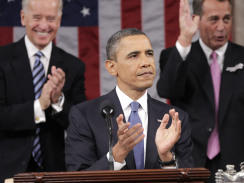 The theme of President Obama’s State of the Union address last night was winning the future, and investing in America’s infrastructure was an integral part of it. Other nations have outpaced our investment in roads and railways, and our own engineers have graded our infrastructure a “D,” he noted.
The theme of President Obama’s State of the Union address last night was winning the future, and investing in America’s infrastructure was an integral part of it. Other nations have outpaced our investment in roads and railways, and our own engineers have graded our infrastructure a “D,” he noted.
So what do you want from transportation?
We noticed that the folks at AASHTO are asking all their visitors to weigh in and “tell Congress” what they want to see in a transportation bill, and more broadly, what they think we need to be building and doing with our transportation dollars. During the six-week campaign, people can use AASHTO’s Facebook page to […]
Blaming the pedestrian won’t solve the problem
Walking in the ditch Originally uploaded by Transportation for America to Flickr. If this woman got hit by car, it’s probably her fault, right? Photograph by Stephen Lee Davis/Transportation for America. We noted on Twitter this morning a story in the USA Today about pedestrian deaths increasing in 2010, halting a decline that had been […]
California needs smart station planning to maximize high-speed rail’s benefits
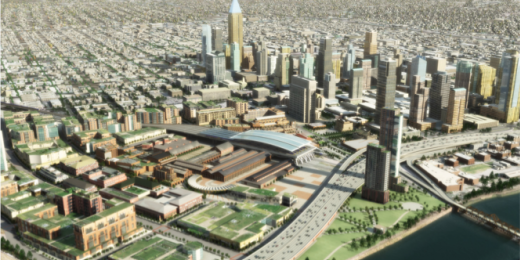 High-speed rail investment has the potential to yield great economic and environmental rewards for California, but only if communities make smart decisions about land-use and growth at and around new stations. A new report prepared by the San Francisco Planning and Urban Research Association offers prescriptions for how communities can prepare for rail investments.
High-speed rail investment has the potential to yield great economic and environmental rewards for California, but only if communities make smart decisions about land-use and growth at and around new stations. A new report prepared by the San Francisco Planning and Urban Research Association offers prescriptions for how communities can prepare for rail investments.
What do the House rule changes mean for transportation spending?
Earlier this week the House adopted rules for this new session of Congress. It’s a bit of inside baseball that can be hard to decipher, but these rules determine how bills are considered by lawmakers and what bills can and cannot do. Streetsblog Capitol Hill covered this issue on Monday and today, but it’s worth […]
Could another new passenger rail line be facing the ax?
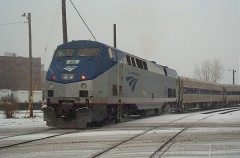 Potentially following in the footsteps of Wisconsin and Ohio, the Republicans in the state legislature are considering the possibility of killing Iowa’s portion of a planned higher speed passenger rail line from Chicago to Iowa City that would pass through the Quad Cities and the new Moline (Ill.) multimodal transportation hub funded by a TIGER grant.
Potentially following in the footsteps of Wisconsin and Ohio, the Republicans in the state legislature are considering the possibility of killing Iowa’s portion of a planned higher speed passenger rail line from Chicago to Iowa City that would pass through the Quad Cities and the new Moline (Ill.) multimodal transportation hub funded by a TIGER grant.
Debunking some myths about the gas tax in a new report
A new report out today contains some fascinating facts about the federal gas tax – a subject sure to be of great contention as this new Congress tries to decide whether to raise it and how best to spend it. “Do Roads Pay for Themselves? Setting the Record Straight on Transportation Funding,” a report from the U.S. Public Interest Research Group.
Smarter transportation case study #9: New Mobility Hub Network in Chennai, India
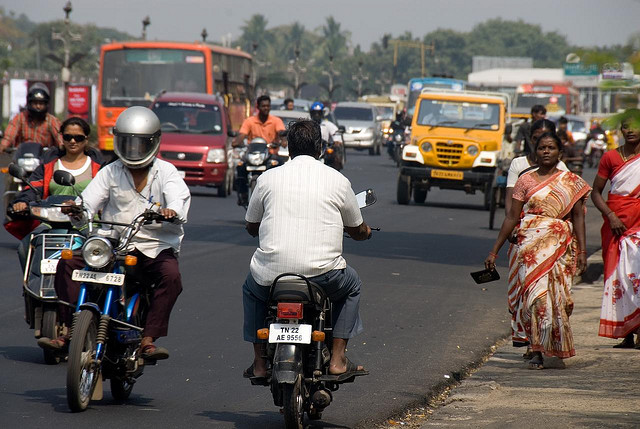 Automobile use in Chennai, India is growing by 13 percent a year and a new transportation hub has helped to integrate the city’s diverse transit network for both residents and visitors. Our new report on smarter mobility demonstrates how existing and emerging technologies can squeeze more capacity from over-burdened highways, help commuters avoid traffic delays and expand and improve transportation options, all while saving money and creating jobs. (From our series of 14 case studies.)
Automobile use in Chennai, India is growing by 13 percent a year and a new transportation hub has helped to integrate the city’s diverse transit network for both residents and visitors. Our new report on smarter mobility demonstrates how existing and emerging technologies can squeeze more capacity from over-burdened highways, help commuters avoid traffic delays and expand and improve transportation options, all while saving money and creating jobs. (From our series of 14 case studies.)
Smarter transportation case study #8: Bus Rapid Transit Priority in Salt Lake City, Utah
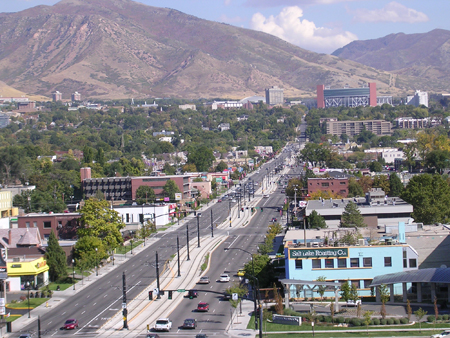 Rapid growth and a growing tourism industry prompted Salt Lake City officials to bring increased efficiency and connectivity to the area’s bus system. Our new report on smarter mobility demonstrates how existing and emerging technologies can squeeze more capacity from over-burdened highways, help commuters avoid traffic delays and expand and improve transportation options, all while saving money and creating jobs. (From our series of 14 case studies.)
Rapid growth and a growing tourism industry prompted Salt Lake City officials to bring increased efficiency and connectivity to the area’s bus system. Our new report on smarter mobility demonstrates how existing and emerging technologies can squeeze more capacity from over-burdened highways, help commuters avoid traffic delays and expand and improve transportation options, all while saving money and creating jobs. (From our series of 14 case studies.)
Smarter transportation case study #7: Bike sharing program in Pottstown, Pa.
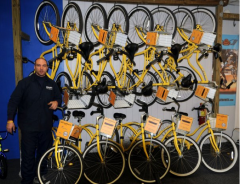 A first-in-the-region bikesharing program has increased transportation options and improved public health in this town 40 miles outside Philadelphia. Our new report on smarter mobility demonstrates how existing and emerging technologies can squeeze more capacity from over-burdened highways, help commuters avoid traffic delays and expand and improve transportation options, all while saving money and creating jobs. (From our series of 14 case studies.)
A first-in-the-region bikesharing program has increased transportation options and improved public health in this town 40 miles outside Philadelphia. Our new report on smarter mobility demonstrates how existing and emerging technologies can squeeze more capacity from over-burdened highways, help commuters avoid traffic delays and expand and improve transportation options, all while saving money and creating jobs. (From our series of 14 case studies.)
U.S. Department of Housing and Urban Development will award $100 million in grants for livable and sustainable communities
For the first time in the agency’s history, the U.S. Department of Housing and Urban Development awarded $100 million in grants today to help communities become more livable and sustainable, by connecting housing to jobs and transportaiton options. The 45 regional winners from communities small and large across the country embody precisely the kind of innovation and creativity federal policy should be supporting.
Smarter transportation case study #6: Managed lanes with peak-period transit discounts in Minneapolis
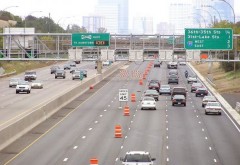 In Minneapolis, priority lanes and differential pricing have cleared a key interstate during peak hours and allowed more commuters to utilize public transit. Our new report on smarter mobility demonstrates how existing and emerging technologies can squeeze more capacity from over-burdened highways, help commuters avoid traffic delays and expand and improve transportation options, all while saving money and creating jobs. (From our series of 14 case studies.)
In Minneapolis, priority lanes and differential pricing have cleared a key interstate during peak hours and allowed more commuters to utilize public transit. Our new report on smarter mobility demonstrates how existing and emerging technologies can squeeze more capacity from over-burdened highways, help commuters avoid traffic delays and expand and improve transportation options, all while saving money and creating jobs. (From our series of 14 case studies.)
Smarter transportation case study #5: Traffic signal optimization; Portland, Oregon
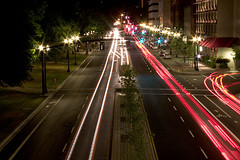 Portland officials improved the timing and coordination of traffic signals in 17 key intersections, resulting in lower auto emissions and less traffic. Our new report on smarter mobility demonstrates how existing and emerging technologies can squeeze more capacity from over-burdened highways, help commuters avoid traffic delays and expand and improve transportation options, all while saving money and creating jobs.
Portland officials improved the timing and coordination of traffic signals in 17 key intersections, resulting in lower auto emissions and less traffic. Our new report on smarter mobility demonstrates how existing and emerging technologies can squeeze more capacity from over-burdened highways, help commuters avoid traffic delays and expand and improve transportation options, all while saving money and creating jobs.
Smarter transportation case study #4: Dynamic Parking Pricing, San Francisco
 SFpark has reduced idle driving time and cut congestion by making it easier to track and locate parking in San Francisco. In 2009, 30 percent of driving San Francisco consisted of drivers circling around the block looking for parking. Now, city officials are pursuing an intelligent parking-pricing model called “SFpark” to cut down on the wasted time and fuel that too often results from this elusive parking search. (From our 14 case studies on smarter transportation.)
SFpark has reduced idle driving time and cut congestion by making it easier to track and locate parking in San Francisco. In 2009, 30 percent of driving San Francisco consisted of drivers circling around the block looking for parking. Now, city officials are pursuing an intelligent parking-pricing model called “SFpark” to cut down on the wasted time and fuel that too often results from this elusive parking search. (From our 14 case studies on smarter transportation.)
Smarter transportation case study #3: Specialized Customer Information: Pittsburgh, Pa.
The ACCESS program integrates non-profit and for-profit transit providers to maximize service for older residents and the disabled. Our new report on smarter mobility demonstrates how these existing and emerging technologies can squeeze more capacity from over-burdened highways, help commuters avoid traffic delays and expand and improve transportation options, all while saving money and creating jobs.
UPDATED: T4 America sends letter to New Jersey Governor Christie on ARC Tunnel
You may have heard the news that the ARC tunnel project in New Jersey is on fragile ground. New Jersey Governor Chris Christie says his office has not made a final decision yet, but he is expected to make some kind of announcement at 1pm press conference this afternoon. Transportation for America prepared a letter to the Governor’s office, touting the “critical importance this project has to the northeast and the nation in general.”
Smarter transportation case study #2: SmartBus Project, Chattanooga, Tenn.
Chattanooga’s SmartBus project has produced significant savings and made buying tickets and finding buses easier than ever. Our new report — including these 14 case studies — on smarter mobility demonstrates how existing and emerging technologies can squeeze more capacity from over-burdened highways, help commuters avoid traffic delays and expand and improve transportation options, all while saving money and creating jobs.



















